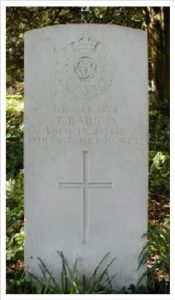30th (Railway) Labour Battalion, Royal Engineers

Thomas Baughn probably responded to a 1916 newspaper advertisement seeking specialist workers above the normal age for enlistment, to join the Royal Engineers but served only fifteen months, before being discharged on fitness grounds.
He was born in 1870 in South Cerney, one of six children born to John Baughn (1838-1904) and wife Kezia Herbert (née Schurmer: 1830-1908).
John Baughn worked as an agricultural labourer and thatcher. For many years, at the end of the 1800s the family home was at Ham Alley, South Cerney.
Thomas married Emma Jones (1869-1929) on 17 April 1895 at South Cerney Parish Church.
At that time, he was an agricultural labourer and that was probably his occupation up until he joined the Army. After the marriage he and Emma went to live in Station Road and later moved to School Street, both in South Cerney. They had seven children and six were surviving by the time of the 1911 Census: their first born died between the age of one and two.
As is often the case, no Army Service or Pension Record has survived for Thomas.
However the records for the issuance of Silver War Badges (which service personnel, discharged as a result of wounds or sickness received) shows that Thomas enlisted on 17 April 1916 (his 21st wedding anniversary) and was discharged, due to sickness, in 25 July 1917.
In April 1916 advertisements appeared in the local newspapers for the recruitment of 1,000 men, aged 41 to 47, for service with the 30th (Railway) Labour Battalion, Royal Engineers (also known as ‘The Gloucestershire Labour Battalion’).
The battalion had been formed on 3 April 1916 for the duration of the war, for service in France, to assist Royal Engineer (RE) Railway troops currently serving with the 113 Company, RE. The recruitment was for men over the normal age limit for recruitment, who would be trained and equipped at Longmoor, Hampshire, before proceeding overseas.
Men were required who were accustomed to work on railway construction and other construction and building works. No doubt Thomas’s background in labouring was seen as an advantage. Between 17 May and 22 July 1916, companies of the 30th Battalion were sent to the Western Front, where they joined up with either the 281st Army Transport Company, 70th Wagon Erecting Company or 282nd Army Troops Company, RE.
The only hint that we of the reason for Pioneer Thomas Baughn’s discharge on 25 July 1917, is contained in a recently released Pension Record card, which states that he was receiving a pension due to ‘VDH’, which stands for ‘valvular disease of the heart’. Work on railway construction and maintenance would have been very strenuous and at the age of 45 or 46, it would he brought to the fore any underlying heart condition.
It is not known if heart disease was the cause of Thomas’ death on 19 November 1920 at the age of 51 but this seems highly probable. He was buried in the churchyard of All Hallows, South Cerney on 23 November 1920: the church burial record is annotated (that the burial took place) ‘under Coroner’s Warrant’. His grave is now marked by a standard CWGC headstone.
Thomas and Emma’s eldest surviving son, Walter Thomas, born in 1897, also served for a short period of the Great War, with the Glosters and survived.
Researched by Graham Adams 16th November 2020
